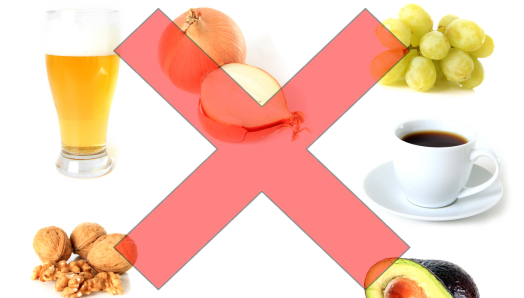By: Dr. Victoria Bennett, Veterinary Advisor, CNIB Guide Dogs
Amongst the top 10 most common toxicities in pets reported to ASPCA are over the counter and prescription medications (both humans and pet), foods – especially chocolate – household chemicals (disinfection wipes and cleaners), pesticides (rodenticides), insecticides (e.g. ant traps), and plants including Marijuana.
Four key facts required to determine the severity of a toxicity:
- What? Product and product label details. Eaten, topical exposure, inhale etc.
- How much? Number of tablets, grams of product etc.
- When? Time or estimated time of ingestion.
- Who? What is your dog’s weight (breed) and age?
Always consult a veterinarian for advice before inducing vomiting. A standard first aid kit with the following items can be helpful for inducing vomiting: Hydrogen peroxide 3% and a 12 ml syringe ideally within 2-4 hours of ingesting substance. Give orally via syringe 1 ml per lb. (max 45 ml per dose) repeat once as needed, more effective if fed prior to administration. Vomiting usually occurs within 15 mins of administration.
Never induce vomiting in a dog with a history of or currently exhibiting signs of any neurological, cardiac, respiratory disease or weakness. Only induce vomiting of a substance that is safe to vomit up. Sharp or large objects may get stuck and alkalis, acids corrosive agents and hydrocarbons may cause further damage if vomited.
Providing the four key facts will assist your vet in predicting the severity of the toxicity and a recommended treatment plan that may be as simple as inducing vomiting at home for the following items:
 Chocolate contains theobromine and caffeine (Methylxanthines). Darker chocolate is more toxic than milk or white chocolate. Symptoms range from gastrointestinal upset, hyperactivity, increased heart rate tremors and death. Based on your dog’s symptoms and by using the online chocolate toxicity calculator with the 4 key facts will indicate whether an emergency vet visit is needed.
Chocolate contains theobromine and caffeine (Methylxanthines). Darker chocolate is more toxic than milk or white chocolate. Symptoms range from gastrointestinal upset, hyperactivity, increased heart rate tremors and death. Based on your dog’s symptoms and by using the online chocolate toxicity calculator with the 4 key facts will indicate whether an emergency vet visit is needed.- Dogs are uniquely sensitive to Xylitol or other sugar alcohols ending in “-tol” used as artificial sweeteners “hidden” in many “sugar free” products (baked goods, desserts, candies chewing gum, flavoured drinks, peanut butter, cough syrups, vitamins or other medications or supplements, protein bars, cosmetics, diapers, skin gels and sunscreens, even some sports clothing for its humectant, antimicrobial cooling effects). Xylitol causes life threatening low blood sugar and potentially irreversible liver failure.
- Grapes and raisins cause acute kidney injury and is not necessarily dose dependent in dogs. Toxicities can occur with 4-5 grapes in a small dog 25 in some large dogs. Symptoms may include vomiting diarrhea, distended abdomen, lethargy with progression to kidney disease with changes in drinking urination.
- Onions and garlic cause hemolytic anemia (destruction of red blood cells) either through single or multiple low dose exposures with a delay in adverse effects of 3-5 days post ingestion.
- Macadamia nuts and moldy foods are also toxic and should never be given to your dog.
- Rising bread dough is another life-threatening item, on ingestion the dog’s body heat causes the dough to rise further in the stomach as well as the production of toxic ethanol gas.
- Marijuana plant products inhaled or ingested (dose and formulation dependent) typically causes dogs initially to vomit become depressed/sleepy, cold, have a slower heart rate and dribble urine within 1 – 3 hours depending on dose may progress to life threatening issues including seizures. Dogs have a higher concentration of cannabinoid receptors in their brain as well as receptors in their skin and salivary glands which potentiates the effect compared to other species. Dogs with atopic dermatitis are particularly sensitive. A THC urine test may not be reliable in dogs.
Be prepared to induce vomiting at home, know the 4 key facts and always consult a veterinarian or pet poison control if you suspect a toxicity or if you know your dog has ingested a toxic substance.
